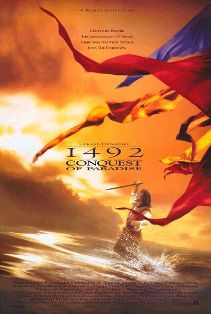 W
W1492: Conquest of Paradise is a 1992 English-language French-Spanish epic historical drama film directed and produced by Ridley Scott and starring Gérard Depardieu, Armand Assante, and Sigourney Weaver. It portrays a fictionalized version of the travels to the New World by the Italian explorer Christopher Columbus and the effect this had on indigenous peoples.
 W
WAssassin's Creed is a 2016 science fiction action film based on the video game franchise of the same name. The film is directed by Justin Kurzel, written by Michael Lesslie, Adam Cooper and Bill Collage, and stars Michael Fassbender, as well as Marion Cotillard, Jeremy Irons, Brendan Gleeson, Charlotte Rampling and Michael K. Williams.
 W
WAtlántida (Atlantis) is an opera in a prologue and three parts, by Manuel de Falla, based on the Catalan poem L'Atlàntida by Jacint Verdaguer. Falla worked on the score for twenty years but had not completed it at his death in Argentina in 1946; his disciple Ernesto Halffter prepared the score for performance.
 W
WBill & Ted's Excellent Adventures is a 1990 animated television series spinoff from the 1989 film of the same title, following the misadventures of two time-travelling slackers as they travel into the distant past and future.
 W
WA bust of Christopher Columbus was installed in Lancaster, Pennsylvania, United States in 1992. The bust was dedicated at the Lancaster County Courthouse on the 500th anniversary of Christopher Columbus’ discovery of America. Designed by Art Research and Technology of Lancaster at a cost of $13,000, the bronze bust depicts Columbus with chin-length hair, wearing a period hat and a pleated shirt and cloak. It was surveyed by the Smithsonian Institution's "Save Outdoor Sculpture!" program in 1995.
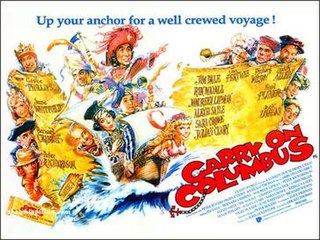 W
WCarry On Columbus is a 1992 British comedy film, the 31st and final release in the Carry On film series (1958–1992). The film was a belated entry to the series, following 1978's Carry On Emmannuelle. It was produced to coincide with the 500th anniversary of Christopher Columbus's arrival in the Americas.
 W
WChristophe Colomb is an opera in two parts by the French composer Darius Milhaud. The poet Paul Claudel wrote the libretto based on his own play about the life of Christopher Columbus, Le Livre de Christophe Colomb. The opera was first performed at the Staatsoper, Berlin, on 5 May 1930 in a German translation by Rudolph Stephan Hoffmann. Milhaud thoroughly revised the work and produced a second version around 1955. The opera is on a large scale and requires many resources for its staging. As in many of his other works, Milhaud employs polytonality in parts of the score.
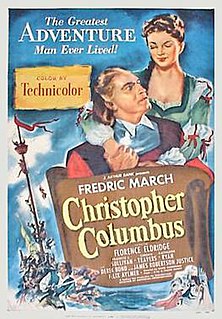 W
WChristopher Columbus is a 1949 British biographical film starring Fredric March as Christopher Columbus and Florence Eldridge as Queen Isabella. It is loosely based on the novel Columbus by Rafael Sabatini with much of the screenplay rewritten by Sydney and Muriel Box.
 W
W"Christopher Columbus" is a song by British-Norwegian boyband A1, released as the third single from their fifth studio album, Rediscovered. The track inspired the band to name the album Rediscovered, as the given title was the name of one of the greatest explorers in the world, Christopher Columbus. The title of this track and the album link to one another. No music video was created for the track.
 W
WChristopher Columbus is a television miniseries broadcast in Italy and the United States in 1985. In six hours, the series told the story of the life of Christopher Columbus, with Gabriel Byrne starring as the explorer.
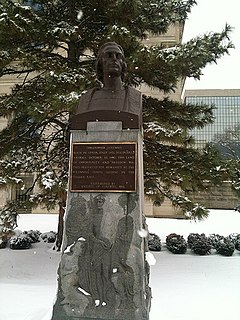 W
WChristopher Columbus is a public artwork by Italian artist Enrico Vittori and located on the grounds of the Indiana Statehouse in Indianapolis, Indiana. The sculpture was installed on the southwest corner of the Indiana Statehouse lawn in 1920 as a gift from Italian immigrant communities in Indiana.
 W
WChristopher Columbus Before the Council of Salamanca is an 1841 painting by the German-American artist Emanuel Leutze, now in the Louvre in Paris. It was lent to the Musée des beaux-arts de Lyon in 2014 for its exhibition L'invention du Passé. Histoires de cœur et d'épée 1802-1850..
 W
WChristopher Columbus: The Discovery is a 1992 American historical adventure film directed by John Glen. It was the last project developed by the father and son production team of Alexander and Ilya Salkind. The film follows events after the fall of the Emirate of Granada, and leads up to the voyage of Columbus to the New World in 1492.
 W
WThe Columbiad (1807) is a philosophical epic poem by the American diplomat and man of letters Joel Barlow. It grew out of Barlow's earlier poem The Vision of Columbus (1787). Intended as a national epic for the United States it was popular with the reading public, and was compared with Homer, Virgil and Milton.
 W
WThe Columbian half dollar is a coin issued by the Bureau of the Mint in 1892 and 1893. The first traditional United States commemorative coin, it was issued both to raise funds for the 1893 World's Columbian Exposition and to mark the quadricentennial of the first voyage to the Americas of Christopher Columbus, whose portrait it bears. The Columbian half dollar was the first American coin to depict a historical person.
 W
WThe Columbian Issue, often known as simply the Columbians, is a set of 16 postage stamps issued by the United States to commemorate the World's Columbian Exposition held in Chicago during 1893. The finely-engraved stamps were the first commemorative stamps issued by the United States, depicting various events during the career of Christopher Columbus and are presently much valued by collectors.
 W
WColumbus is a romantic adventure novel by the British writer Rafael Sabatini which was first published in 1941. It depicts the life of Christopher Columbus at the Spanish court, his voyages across the Atlantic Ocean in which he discovered the Americas and his relationship with the mother of his second son Beatriz Enríquez de Arana, whom he never married.
 W
WColumbus Breaking the Egg is a 1752 engraving by English artist William Hogarth. Issued as the subscription ticket for his treatise on art, The Analysis of Beauty, it depicts an apocryphal tale concerning Christopher Columbus's response to detractors of his discovery of the New World. Hogarth uses the story as a parallel to what he considered his own discoveries in art.
 W
WColumbus Doors (1855–1861), also known as the Rogers Doors, are a pair of massive bronze doors modeled by sculptor Randolph Rogers for the East Front of the United States Capitol in Washington, DC. They open into the Rotunda, and depict events from the life of Christopher Columbus.
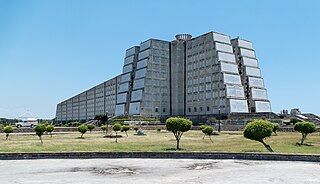 W
WColumbus Lighthouse is a mausoleum monument located in Santo Domingo Este, Dominican Republic, in tribute to Christopher Columbus.
 W
WThe Columbus murals are a series of twelve murals depicting Christopher Columbus, painted in the 1880s by Luigi Gregori and displayed in the Main Building at the University of Notre Dame in Indiana, US. The murals have been a source of controversy in recent decades for their romanticized portrayal of Columbus and his relationship with Native Americans.
 W
WThe Columbus Obelisk is one of three monuments to Christopher Columbus in Baltimore, Maryland. Erected in 1792, the obelisk is the oldest monument to Christopher Columbus in the United States.
 W
WThe Columbus Quincentenary (1992) was the 500th anniversary of Christopher Columbus' 1492 arrival in America. Similar to Columbus Day, the annual celebration of Columbus' arrival, the quincentenary was viewed contentiously, as different cultures and peoples had different ways of understanding Columbus' role in history. Certain institutions sought to celebrate this anniversary in commemoration Columbus' momentous colonial and imperial achievements. Spain's Universal Exposition of Seville (1992) was elaborately planned to highlight Columbus' work and the overall European Age of Discovery. Italy's International Exposition of Genoa (1992) was themed "Christopher Columbus, The Ship and the Sea." In 1984, United States designated the Christopher Columbus Quincentenary Jubilee Commission to execute a commemoration in honor of Columbus. In total, over 20 countries, including several Latin American countries and Japan, designated committees to plan quincentennial celebrations.
 W
WConquistadores: Adventvm is a 2017 Spanish historical drama miniseries directed by Israel del Santo for Movistar+ and starring Aitana Sánchez-Gijón, Juan Díaz Pardeiro, Denis Gómez, Miguel Lago and Mauro Muñiz de Urquiza.
 W
WCristoforo Colombo is an opera in four acts and an epilogue by Alberto Franchetti to an Italian libretto by Luigi Illica. It was written in 1892 to commemorate the 400th anniversary of Christopher Columbus' arrival in America.
 W
WDawn of America is a 1951 Spanish historical adventure film directed by Juan de Orduña and starring Antonio Vilar, María Martín and José Suárez. The film depicts the discovery of the Americas by Christopher Columbus in the late fifteenth century.
 W
WThe Discovery of America by Christopher Columbus is a painting by artist Salvador Dalí, begun in 1958 and finished in 1959. It is over 14 feet tall and over 9 feet wide, one in a series of large paintings Dalí did during this era.
 W
WEin Mann, der sich Kolumbus nannt is the title of a folk or children's song. It first became the melody of Ich bin der Doktor Eisenbart in the Scherzliederbuch Der Pott in 1936. The song tells of the "discovery of America" by Christopher Columbus. Immediately after its first publication, it was widely used in publications of National Socialist organizations. Even after the World War II it found its way into German children's song books.
 W
WGuardians of the Lost Library is a 1993 comic book story made by Don Rosa for The Walt Disney Company, mentioned by Comics Buyer's Guide as "possibly the greatest comic book story of all time". Although afraid at the time of its creation of cramming too many historical details into the story, Rosa himself mentions in Uncle Scrooge #383 that in fan mail he receives to this day, Guardians of the Lost Library to his own surprise is often referred to as "'the best Rosa story' or 'the best Duck story' or even 'the best comic book story' (?!!) that fans say they've ever read."
 W
WA History of the Life and Voyages of Christopher Columbus is a non fiction biographical account of Christopher Columbus written by Washington Irving in 1828. It was published in four volumes in Britain and in three volumes in the United States. The work was the most popular treatment of Columbus in the English-speaking world until the publication of Samuel Eliot Morison's biography Admiral of the Ocean Sea in 1942. It is one of the first examples of American historical fiction and one of several attempts at nationalistic myth-making undertaken by American writers and poets of the 19th century. It also helped to perpetuate the myth of the flat Earth.
 W
WThe Lost Charts of Columbus is a 1995 Donald Duck comic by Don Rosa, a sequel to Carl Barks' 1952 story The Golden Helmet.
 W
WThe Magic Voyage is a 1992 German animated fantasy film produced and directed by Michael Schoemann. It was released in Germany by Bavaria Film on 14 February 1992. The film was later dubbed in English and released in the United States and Canada: two English dubs were actually produced. The first one was a rare English dub released by Atlas Film, while the second English dub was produced by Hemdale Film Corporation, released as The Magic Voyage on 23 April 1993 with a new and more well-known voice cast. The latter dub had a different music soundtrack, and both English dubs had different translations.
 W
WMarconi Plaza is an urban park square located in South Philadelphia, Philadelphia, Pennsylvania. The plaza was named to recognize the 20th-century cultural identity in Philadelphia of the surrounding Italian-American enclave neighborhood and became the designation location of the annual Columbus Day Parade.
 W
WEl ministerio del tiempo is a Spanish fantasy television series created by Javier and Pablo Olivares and produced by Onza Partners and Cliffhanger for Televisión Española. It premiered on 24 February 2015 on TVE's main channel La 1. The series follows the exploits of a patrol of the fictional Ministry of Time, which deals with incidents caused by time travel that can make differences in our current time.
 W
WNight at the Museum is a 2006 fantasy-comedy film directed by Shawn Levy and written by Robert Ben Garant and Thomas Lennon. It is based on the 1993 children's book of essentially the same name, by Croatian illustrator Milan Trenc. The film stars Ben Stiller as Larry Daley, a divorced father who applies for a job as a night watchman at New York City's American Museum of Natural History and subsequently discovers that the exhibits, animated by a magical Egyptian artifact, come to life at night. 20th Century Fox released the film on December 22, 2006, and it grossed $574.5 million worldwide. Two sequels were released: Night at the Museum: Battle of the Smithsonian in 2009, and Night at the Museum: Secret of the Tomb in 2014. A remake is in development for the streaming service Disney+.
 W
WPastwatch: The Redemption of Christopher Columbus (1996) is the first science fiction novel in a proposed Pastwatch series by Orson Scott Card. The book's focus is the life and activities of explorer, Christopher Columbus. Much of the action deals with a group of scientists from the future who travel back to the 15th century in order to change the pattern of European contact with the Americas. These alternate with chapters describing Columbus' career and his efforts to obtain backing to his project of travelling across the ocean - much of which can be considered as historical fiction.
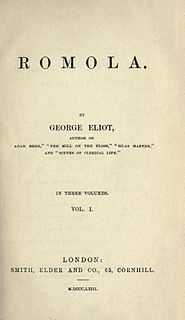 W
WRomola (1862–63) is a historical novel written by Mary Ann Evans under the pen name of George Eliot set in the fifteenth century. It is "a deep study of life in the city of Florence from an intellectual, artistic, religious, and social point of view". The story takes place amidst actual historical events during the Italian Renaissance, and includes in its plot several notable figures from Florentine history.
 W
WStan Freberg Presents the United States of America Volume One: The Early Years is a 1961 American comedy album with music and dialogue written by Stan Freberg, released as Capitol W/SW-1573 in 1961. Freberg satirizes episodes of the history of the United States from 1492 until the end of the Revolutionary War in 1783. The album combined dialogue and song in a musical theater format. Billy May orchestrated and conducted the music, with the Jud Conlon Singers providing background vocals.
 W
WThe Story of Mankind is a 1957 American fantasy film, very loosely based on the nonfiction book The Story of Mankind (1921) by Hendrik Willem van Loon. The film was directed and co–produced by Irwin Allen and released by Warner Bros. The all-star cast movie was a critical failure.
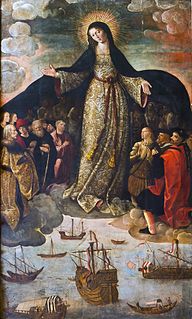 W
WThe Virgin of the Navigators is a painting by Spanish artist Alejo Fernández, created as the central panel of an altarpiece for the chapel of the Casa de Contratación in Alcázar of Seville, Seville, southern Spain. It was probably painted sometime between 1531 and 1536. Carla Rahn Phillips has suggested that it represents Christopher Columbus as a European magus-king reinforcing "the notion that the Spanish Empire represented the fulfillment of biblical prophecy to bring the Christian message to all the peoples of the world.
 W
WThe Voyage is an opera in three acts by the American composer Philip Glass. The English/Latin/Spanish libretto was written by David Henry Hwang.